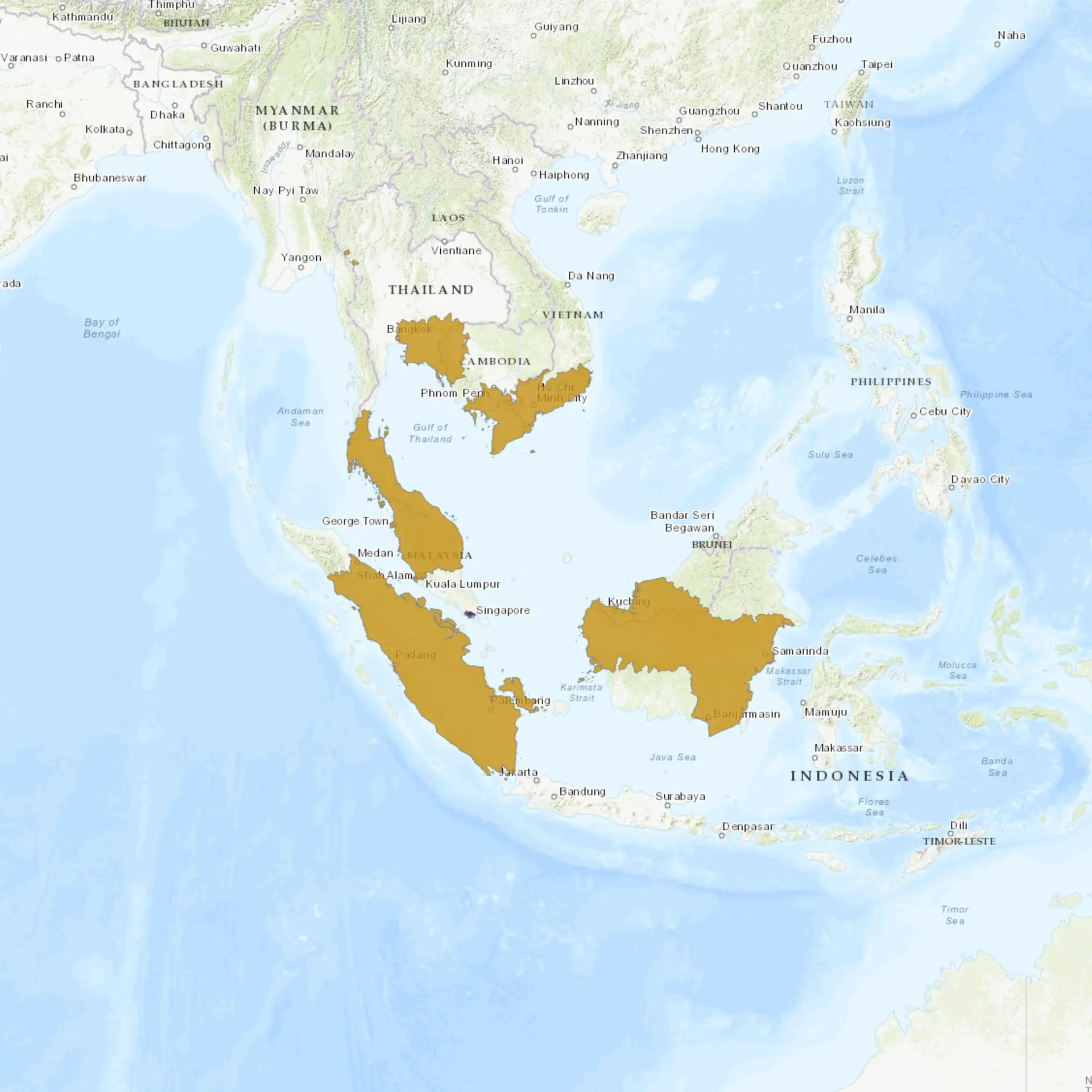Overview
The Asian Arowana, also known as the Dragon Fish, is a freshwater fish native to Southeast Asia’s rivers and waterways. This species is highly revered in many Asian cultures for its majestic appearance and is believed to bring good luck and prosperity, making it a sought-after aquarium fish. The Asian Arowana has a distinctive, elongated body with large, metallic scales that can appear in various colors, including gold, red, silver, and green, depending on the specific variety. These fish are known for their impressive size, capable of growing up to 3 feet in length in the wild, and have a similar potential in captivity under optimal conditions.
Asian Arowanas are surface dwellers, primarily feeding on a diet that includes insects, small fish, occasionally amphibians and other small aquatic animals. They possess a unique hunting technique, using their powerful swimming ability to leap out of the water to catch prey. This predatory behavior is a testament to their adaptability and prowess as hunters. The species is characterized by its long, flowing fins and barbels, which add to its dragon-like appearance, further cementing its status as a symbol of power and wealth in various Asian cultures.
Conservation efforts have become increasingly important for the Asian Arowana due to habitat loss, pollution, and overfishing for the aquarium trade. Listed as endangered, the trade of wild-caught specimens is regulated under CITES to protect remaining populations from depletion. Captive breeding programs have successfully produced fish for the aquarium trade, helping to reduce pressure on wild stocks. The fascination with Asian Arowanas continues growing, driving efforts to better understand and conserve this iconic species.
Taxonomy
Kingdom
Phylum
Class
Order
Family
Genus
Species
Type
Current distribution:
Asian Arowanas are found in various Southeast Asian countries, including parts of Indonesia, Malaysia, Thailand, Cambodia, and Vietnam. However, their distribution has become increasingly fragmented due to habitat loss and overfishing. Protected areas and wildlife reserves play a vital role in the conservation of the Asian Arowana, providing sanctuaries where populations can be monitored and preserved.
The international trade of Asian Arowanas is regulated under CITES, with captive breeding programs supplying the demand for aquarium specimens. This has helped to alleviate some of the pressures on wild populations, allowing for focused conservation efforts to restore and protect their natural habitats. The species' status as endangered underscores the importance of continued vigilance in conservation practices to ensure their survival in the wild.
Physical Description:
The Asian Arowana is renowned for its vibrant colors and metallic sheen, with scales that resemble coins, contributing to its symbolism of wealth and prosperity. The body shape is elongated and streamlined, facilitating their swift movements through water, which is particularly useful for their surface-feeding habits. Depending on the variety, the coloration of Asian Arowanas can range from deep reds and golds to more subtle silvers and greens, each with its unique appeal and associated cultural significance. The fish’s dorsal and anal fins run almost the length of its body, culminating in a fan-like tail fin that enhances its graceful swimming motion.
Notably, the mouth of the Asian Arowana is large and upturned, an adaptation that enables it to feed on prey at the water’s surface. Its eyes are distinctive, often bright and alert, adding to its intense and formidable appearance. Juvenile Arowanas have a more subdued coloration, which intensifies as they mature, a process that can take several years. The size and health of an Arowana are greatly influenced by its living conditions, with those in the wild typically achieving greater lengths due to the abundance of space and food.

Lifespan: Wild: ~20 Years || Captivity: ~60 Years

Weight: Male & Female: 10-13 lbs (160-208 oz)

Length: Male & Female: 35-36 in (90-91 cm)

Top Speed: 5 mph (8 km/h)
Characteristic:
Native Habitat:
The Asian Arowana is indigenous to Southeast Asia. It thrives in slow-moving rivers, lakes, and wetlands, which provide the dense vegetation and ample space necessary for the species’ survival. The water conditions in these environments are typically acidic to neutral, with temperatures ranging from 75 to 86°F (24 to 30°C), ideal for the Arowana’s health and growth.
Human activities such as deforestation, pollution, and dam construction threaten the species’ natural habitat, leading to a significant decrease in their wild populations. Preserving these freshwater ecosystems is essential not only for the Asian Arowana but also for the myriad of other species that share their habitat. Conservation efforts focused on protecting these areas are crucial for the sustainable management of water resources and the biodiversity they support.
Climate Zones:
Biomes:
WWF Biomes:
Biogeographical Realms:
Continents:
Diet:
Diet & Feeding Habits:
Asian Arowanas are carnivorous, and their diet in the wild mainly consists of insects, small fish, and occasionally small amphibians and reptiles. Their feeding method is quite spectacular, as they are known to leap from the water to catch prey above the surface, a behavior that requires precision and power. In captivity, their diet can be supplemented with various foods, including pellets, frozen feed, and live food, to ensure a balanced nutritional intake.
The feeding habits of Asian Arowanas indicate their predatory nature. They prefer to hunt alone rather than in groups. This solitary behavior is mirrored in their territorial nature, often requiring spacious habitats to thrive. A diet closely mimicking their natural food sources is crucial for maintaining their health and vibrant coloration in captivity. Regular feeding schedules and a diverse diet contribute to the overall well-being of the Asian Arowana, promoting growth and longevity.
Mating Behavior:
Mating Description:
Asian Arowanas are mouthbrooders, with males carrying the fertilized eggs in their mouths until they hatch, a process that underscores the species’ unique reproductive behavior. This parental investment ensures a high survival rate for the offspring, as the male protects them from predators and adverse conditions. Mating occurs during the rainy season when water levels rise, providing abundant space and resources for the breeding pairs.
The courtship ritual involves displays of color and strength, with males competing for the attention of females. Once the eggs are fertilized, the female lays them, and the male collects them in his mouth, carrying them until they hatch. The care provided by the male extends to the newly hatched fry, which remains in the vicinity of his protection for several weeks before becoming independent. This reproductive strategy is a fascinating aspect of the Asian Arowana’s life cycle, showcasing the complexity and diversity of fish breeding behaviors.
Reproduction Season:
Birth Type:
Pregnancy Duration:
Female Name:
Male Name:
Baby Name:
Social Structure Description:
Asian Arowanas are generally solitary creatures with a strong territorial instinct that leads them to defend their space aggressively against intruders. This behavior is more pronounced in males, especially during the breeding season when they carry eggs or fry in their mouths. In the wild, the vastness of their natural habitat allows for establishing territories without significant overlap, reducing the frequency of aggressive encounters.
In captivity, the social dynamics of Asian Arowanas require careful management to prevent stress and aggression, underscoring the need for spacious tanks that mimic their natural environment. The species’ solitary nature does not diminish its appeal; instead, it adds to the mystique and fascination surrounding it, reflecting the complexity of fish behavior and social interactions.
Groups:
Conservation Status:
Population Trend:
The Asian Arowana’s wild population is considered endangered, and numbers are continuing to decline due to a combination of habitat loss, pollution, and overfishing. The species’ popularity in the aquarium trade has led to overexploitation, although captive breeding programs have been established to meet this demand and reduce pressure on wild stocks. The genetic diversity of captive populations is a concern, highlighting the need for careful management and conservation practices.
Efforts to conserve the Asian Arowana include habitat protection, pollution control, and trade regulation through international agreements. Establishing breeding programs and protected areas has been crucial in stabilizing some populations, but ongoing challenges require a multifaceted approach to conservation. Public awareness and engagement are also important, as they foster a greater understanding of the species’ ecological and cultural significance, contributing to its preservation.
Population Threats:
The primary threats to the Asian Arowana include habitat destruction due to deforestation, dam construction, and pollution, which degrade the freshwater environments they depend on. The illegal trade of wild-caught specimens for the aquarium market also poses a significant risk despite international regulations designed to control this trade. Climate change is an emerging threat, with potential impacts on water temperature and quality that could affect the species’ survival.
Conservation strategies must address these threats through habitat restoration, stricter enforcement of wildlife trade laws, and promoting sustainable land and water use practices. Collaboration between governments, conservation organizations, and local communities is essential for effectively protecting the Asian Arowana and its habitat and ensuring a coordinated approach to conservation efforts.
Conservation Efforts:
Conservation efforts for the Asian Arowana include the establishment of protected areas to preserve critical habitats and captive breeding programs aimed at reducing the demand for wild-caught fish. International cooperation under CITES has been instrumental in regulating the trade of Asian Arowanas, helping to prevent overexploitation. Research into the species’ biology and ecology contributes to developing effective conservation strategies, enhancing our understanding of their needs and threats.
Education and outreach programs play a vital role in raising awareness about the Asian Arowana’s endangered status and the importance of conservation efforts. Engaging local communities in conservation initiatives ensures their participation in protecting the species, leveraging traditional knowledge and practices to support sustainable management. The collective efforts of the global conservation community are crucial for the future survival of the Asian Arowana, demonstrating the importance of collaborative action in addressing the challenges faced by this iconic species.
Additional Resources:
Fun Facts
- The Asian Arowana is often referred to as the “living dragon” or “dragon fish” due to its impressive appearance and dragons’ cultural significance in Asian mythology.
- It is considered one of the world’s most expensive aquarium fish, with some individuals fetching thousands of dollars based on coloration, size, and rarity.
- The species has a primitive lung, allowing it to gulp air from the surface, an adaptation to oxygen-poor waters.
- Asian Arowanas are known for their loyalty to their owners, and there are some anecdotal reports of them recognizing and interacting with people.
- The fish’s scales resemble Chinese coins, a feature that contributes to its status as a symbol of wealth and prosperity.
- Captive breeding has led to various color morphs, including the highly prized “Super Red” and “Golden Crossback” varieties.
- Asian Arowanas can live for over 20 years in captivity, making them long-term companions for those who keep them.
- The conservation of Asian Arowanas has spurred interest in freshwater ecosystem protection, highlighting the interconnectedness of species and their habitats.
- They can jump several feet out of the water, a behavior used in the wild to capture prey.
- The international trade of Asian Arowanas is closely regulated to protect wild populations, with each legally sold fish typically microchipped for identification.








